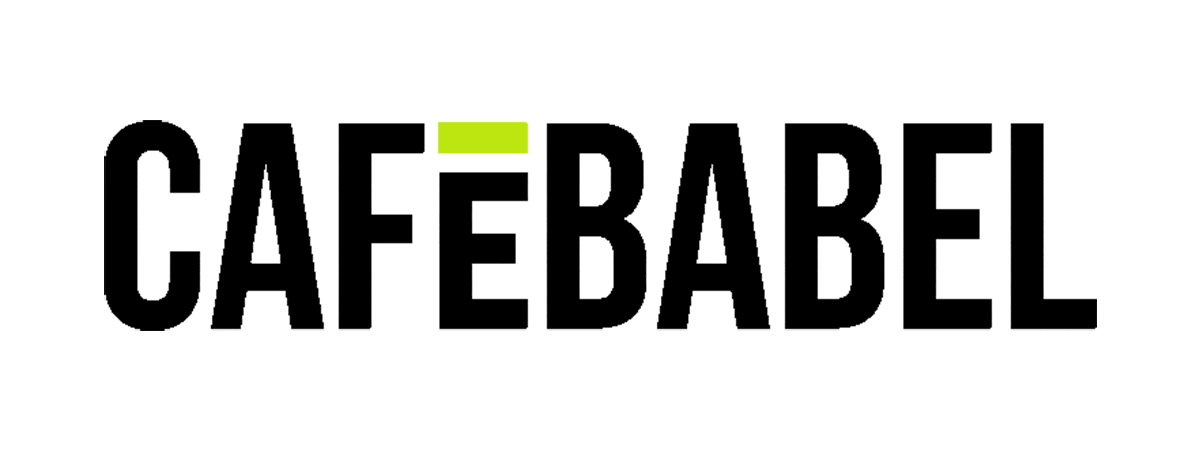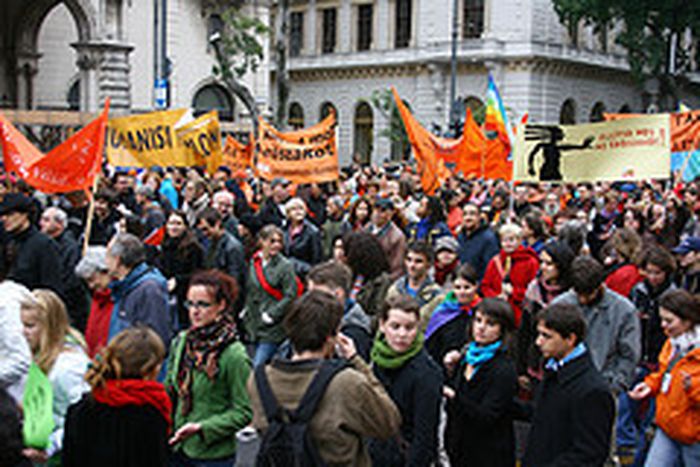
4,000-5,000 joined the civil march of "Tarka Magyar" for non-violence
Published on
October 4, 2008
Various civil groups decided to organize a demonstration called "Tarka Magyar" ("Diverse Hungarian") to commemorate the birthday of Mahatma Gandhi, the International Day of Non-Violence. Organizers hoped the demonstration would be the "biggest non-partisan demonstration since the fall of communism", but turn-out fell far short of the expected 100,000 people.
Eventually, some 4,000-5,000 people joined the march that ran through downtown Budapest on Saturday afternoon to protest against discrimination and violence and support tolerance.
President László Sólyom issued an open letter of support and leaders of all parliamentary parties also expressed their support for the initiative. The organizers were grateful for their moral support but they also emphasized the importance of keeping the “Tarka Magyar” demonstration absolutely bipartisan and a civil initiative. Therefore when Prime Minister Ferenc Gyurcsány announced that he would join the march, the organizers along with Amnesty International requested him to stay away from the demo. Still, as the march reached Heroes' Square, a number of public dignitaries joined the crowd, including the Prime Minister and his family.
Author and film director Kriszta Bodis, acting as spokesperson for the organizers, read aloud Paragraph 70/A of the Hungarian Constitution, which states: "The Republic of Hungary guarantees all persons on its territory human and civil rights and freedom from all types of discrimination - more specifically from any distinction based on race, colour, gender, language, religion, political or other opinions, ethnic or social status, wealth, birth or any other factor." The gathering declared that it condemned all forms of violence and exclusion and promised to use all lawful means at its disposal to prevent acts of violence, intimidation and exclusion.
Participants then began waving pieces of textile in a variety of colours to underline their diversity. They also raised umbrellas of various colors. The music concert of Kati Rácz and the Flush group closed the event what had to be cancelled at the Annual Gay Pride Parade this summer due to the violence of far right activists.
The day of demonstrations in Budapest
September 23, 2008
On September 21, downtown Budapest witnessed three demonstrations containing entirely different people who carried contrasting messages. Demonstrators of the Hungarian Democratic Charter, the Roma minority and the far right groups held their demonstrations at the same time and fairly close to each other in downtown Budapest.
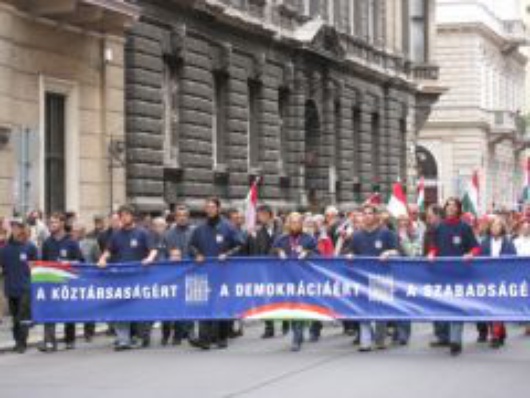 The first demonstration organized by the Hungarian Democratic Charter in central Budapest attracted some 4,500 participants. The foundation of the Hungarian Democratic Charta was initiated by Prime Minister Ferenc Gurcsany in July after far right groups attacked participants of the annual ‘Gay Pride Parade’. (Anti-gay demonstrators pelted the participants of the homosexual parade with eggs in an attempt to disrupt their march). The aim of the Hungarian Democratic Charter is "mobilising the peaceful majority" and "taking a united stand against the radicals". Demonstrators, including Prime Minister Ferenc Gyurcsany (PM), several ministers and other public personalities, gathered on both sides of the Chain Bridge then marched to Parliament. Opposition parties although accused the PM driving the attention away from the serious economical problems of the country and the impotence of his minority government by inciting public fear.
The first demonstration organized by the Hungarian Democratic Charter in central Budapest attracted some 4,500 participants. The foundation of the Hungarian Democratic Charta was initiated by Prime Minister Ferenc Gurcsany in July after far right groups attacked participants of the annual ‘Gay Pride Parade’. (Anti-gay demonstrators pelted the participants of the homosexual parade with eggs in an attempt to disrupt their march). The aim of the Hungarian Democratic Charter is "mobilising the peaceful majority" and "taking a united stand against the radicals". Demonstrators, including Prime Minister Ferenc Gyurcsany (PM), several ministers and other public personalities, gathered on both sides of the Chain Bridge then marched to Parliament. Opposition parties although accused the PM driving the attention away from the serious economical problems of the country and the impotence of his minority government by inciting public fear.
 Roma people held separate a rally for peace and the rule of law, and against fascism near the MPs office building. A demonstration of approximately one thousand people later joined the demonstrators of the Hungarian Democratic Charta and marched with them together to the Parliament.
Roma people held separate a rally for peace and the rule of law, and against fascism near the MPs office building. A demonstration of approximately one thousand people later joined the demonstrators of the Hungarian Democratic Charta and marched with them together to the Parliament.
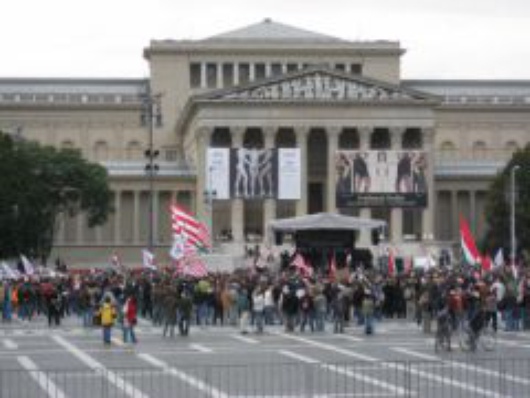 Far right groups also held a rally in their usual venue, the Heros’ square but unlike to their previous gatherings, the audience was limited to three-four hundred people this time. Following the inflammatory speeches of the well-known far right leaders, they started marching to the Soviet monument in Szabadsag square. Their original idea was to commemorate the victims of the communist regime and 'gypsy crime' by bringing empty shoes to the Soviet monument.
Far right groups also held a rally in their usual venue, the Heros’ square but unlike to their previous gatherings, the audience was limited to three-four hundred people this time. Following the inflammatory speeches of the well-known far right leaders, they started marching to the Soviet monument in Szabadsag square. Their original idea was to commemorate the victims of the communist regime and 'gypsy crime' by bringing empty shoes to the Soviet monument. 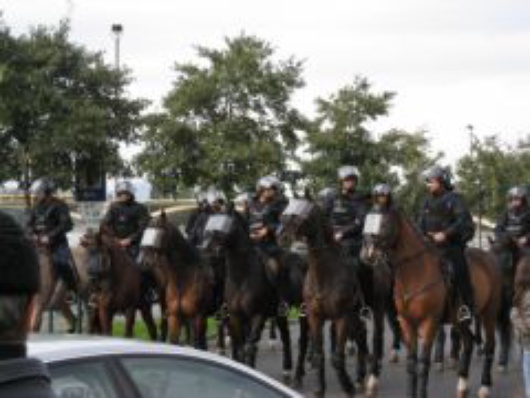 However, the couple hundred rioters soon clashed with the police after they threw Molotov cocktails and cobble stones at the Soviet statue. A Molotov cocktail was also thrown at one police car, and the demonstrators opened hydrants, as well as overturning several benches and rubbish bins. The police answered with tear gas and the rioters were dismissed shortly. Five police officers were injured and 15 people were detained on charges of vandalism.
However, the couple hundred rioters soon clashed with the police after they threw Molotov cocktails and cobble stones at the Soviet statue. A Molotov cocktail was also thrown at one police car, and the demonstrators opened hydrants, as well as overturning several benches and rubbish bins. The police answered with tear gas and the rioters were dismissed shortly. Five police officers were injured and 15 people were detained on charges of vandalism.
Demonstrations are not over in Budapest as several NGOs are preparing to hold an independent demonstration and march entitled Tarka Magyar (multi-colored Hungarians) against violence and exclusion on October 4. The groups say the “over politicized” Hungarian Democratic Charta cannot achieve this goal, and expect a turnout of 100,000.


